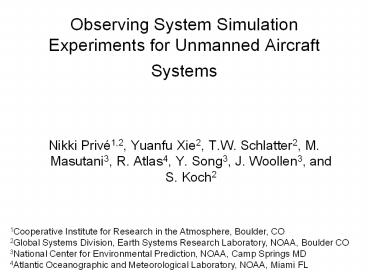Observing System Simulation Experiments for Unmanned Aircraft Systems PowerPoint PPT Presentation
Title: Observing System Simulation Experiments for Unmanned Aircraft Systems
1
Observing System Simulation Experiments for
Unmanned Aircraft Systems
- Nikki Privé1,2, Yuanfu Xie2, T.W. Schlatter2, M.
Masutani3, R. Atlas4, Y. Song3, J. Woollen3, and
S. Koch2
1Cooperative Institute for Research in the
Atmosphere, Boulder, CO 2Global Systems Division,
Earth Systems Research Laboratory, NOAA, Boulder
CO 3National Center for Environmental Prediction,
NOAA, Camp Springs MD 4Atlantic Oceanographic and
Meteorological Laboratory, NOAA, Miami FL
2
Unmanned Aircraft Systems
- UAS consist of the aircraft, communications, and
control/support systems - Many different platforms, each having different
flight and payload capabilities - NOAA UAS Program
- Fill in existing data gaps
- Improve forecasting of tropical cyclones and
atmospheric river events - Climate monitoring in the Arctic and Atlantic
- Fisheries monitoring and enforcement
3
NOAA is looking at a broad range of UAS platforms
to fill data gaps..
Slide courtesy of Sara Summers
4
Slide courtesy of Sara Summers
5
What is an OSSE?
An OSSE is a modeling experiment used to evaluate
the impact of new observing systems on
operational forecasts when actual observational
data is not available.
- A long free model run is used as the truth -
the Nature Run - The Nature Run fields are used to back out
synthetic observations from all current and new
observing systems. - The synthetic observations are assimilated into a
different operational model - Forecasts are made with the second model and
compared with the Nature Run to quantify
improvements due to the new observing system
6
Why a UAS OSSE?
- Assist with selection of optimal choice of UAS
platforms - Are UAS the right choice?
- Combine with manned aircraft and other observing
systems - Design of field experiments
- Flight paths
- Instruments
- UAS platforms
7
OSSE Progress
- Joint OSSE
- Collaboration between many agencies ECMWF, NCEP,
ESRL, NESDIS, GMAO, and others - Nature Run
- 13 month free run of the ECMWF operational model
at T511, 91 sigma levels - Synthetic Observations
- Current observing systems
- Conventional synthetic obs generation completed
- Radiance synthetic obs generation in progess
- UAS synthetic obs generation code available for
dropsonde and in-situ observations - Calibration
- Currently underway using archived real data for a
baseline
8
OSSE Calibration
Examine the synthetic observations in a series of
data denial experiments so that eventual OSSE
results can be put into context with the real
world
- Perform Observing System Experiments (OSEs) using
real observations - Perform OSEs using synthetic observations of
current observing systems - Compare OSE results and adjust synthetic
observations as needed
9
300 mb U-wind Analysis Impact, July-August 2005
10
850 mb U-wind Analysis Impact, July-August 2005
11
300 mb U-wind Forecast Impact, July-August 2005
12
Future Work
- Complete calibration using synthetic observations
- Generate synthetic UAS observations
- Perform data denial experiments for each UAS
testbed

